
This document explains how BOG evaluates and optimizes for dispersion or "fire" performance.
 |
BOG 1.2 offers the GemRayX dispersion brightness optimization target as well as the original BOG version. The dispersion brightness essentially measures the fraction of the gem for which the rays entered the stone at steep angles, leading to greater fire. This document describes the original BOG criterion. |
Dispersion or "fire" refers to a gemstone's ability to return flashes of colour. These flashes arise when a combination of the gemstone material and design succeed in breaking up white light, like a prism. Materials which can do this have a refractive index which varies with wavelength. This means that red light, for example, can take a different path from the environment, through the stone, and to your eye, than blue light does.
Beyond this basic prismatic effect, the presence of facet junctions can increase perceived dispersion. Imagine a beam of white light entering a gem at an angle and direction which produces some dispersion. The tiny spectrum so generated crosses the stone and encounters a facet junction. If things work out right, this junction can split the spectrum, sending some colours off in one direction and the rest somewhere else. This results in a separation of the colours and additional "fire".
Let's focus on a particular part of the gem, say a star facet. If a ray of red light which makes it to your eye via that facet originates on something bright (like a light bulb), but the blue ray path originates somewhere dark, (or perhaps no blue light at all can make it via the facet), then you will perceive a red flash. Essentially, a gemstone with good dispersion or "fire" manages to capture and send to your eye a different "picture" of its surroundings, depending on wavelength. A real-world environment contains a random mix of light and dark areas, and hence we perceive colour in a dispersive gem, even under "white light" illumination.
The Basic PrincipleBOG takes advantage of GemRay's random raytrace output to evaluate, and hence optimize for, the dispersion or fire of a gemstone design. The program raytraces the gem twice, once for red light and once for blue light. BOG then calculates the absolute difference between the two images. (The absolute difference is always a positive number - if a part of the red raytrace is brighter or fainter than the blue, it will be counted as a positive difference). A bigger difference means that the pattern of light returned by the stone changes a lot going from red to blue - this means greater dispersion or "fire". |
Dispersion Values
The dispersion of a gem material is usually characterized by a single number which represents the difference in refractive index at two specified wavelengths. The value you see in tables of gem properties (say 0.013 for quartz) corresponds to the RI difference between red and blue light.
Trivia fans: The exact wavelengths correspond to two dark absorption lines, called the B and G Fraunhofer lines, in the spectrum of the sun. These solar absorption features were discovered by Joseph von Fraunhofer (1787-1826) while studying the dispersion (or "fire") of different materials. The wheel goes round and round.
BOG simply subtracts half the dispersion value from the refractive index to generate the red raytrace, and adds half the dispersion value for the blue. For example, for cubic zirconium (RI=2.2, dispersion 0.06), BOG asks GemRay to raytrace the gem with refractive indices 2.17 (red) and 2.23 (blue).
GemRay's Lighting Models and Dispersion
The easiest way to understand GemRay's lighting models is to imagine the gem, sitting on a flat, infinite plane with its table facet straight up. The viewer is directly above the gem, looking down. Light comes from the "sky," bounces around inside the gem, and a certain fraction is directed straight up to the viewer. The ISO brightness model assumes that the "sky" above the gem is uniformly bright, like a heavily clouded day, while in the COS model, the zenith is very bright, fading to dark at the horizon.
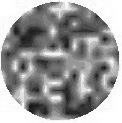 |
The Random Raytrace produced by GemRay assumes the stone is illuminated by a realistic combination of light and dark patches on the "sky" - (see figure at left, and the GemRay documentation at http://www.gemcad.com/gemray.htm) BOG uses the random raytrace for its dispersion evaluation. Because of the mix of light and dark patches, the Random Raytrace lets the user see areas of the stone for which the ray starting points change for red and blue light. For example, red light entering your eye via a certain gem facet may have originated on a bright patch of "sky," whereas the blue ray coming from the same part of the stone may have started on a dark patch. The result is a flash of red "fire". |
A Practical Example
The best way to understand BOG's dispersion calculation is to use it. Reproduced below is the result of BOG's dispersion calculation for a gem cut in tourmaline (RI 1.63, dispersion 0.017). The first panel shows the random raytrace for refractive index 1.6215 and 1.6385 and their absolute difference.
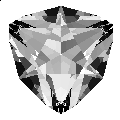 R.I. = 1.6215 (red) |
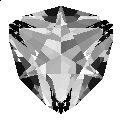 R.I. = 1.6385 (blue) |
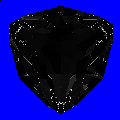 Dispersion Measure 10.3 |
Note the flashes of light concentrated in the corners. This is where the gem will show dispersion. BOG assigned a Dispersion Measure of 10.3 to this design (the blue area was not used in the calculation). Because it represents an average image brightness difference, this Dispersion Measure will vary somewhat from design to design. Hence, it is a good idea to check and balance the weighting factors before optimization. |
In the optimization process, BOG varies the pavilion and crown angles to maximize this Dispersion Measure. There are, of course, caveats. For example, the user should balance "Dispersion/Fire" with the other optimization targets. With only dispersion as a target, BOG may iterate toward a design which windows for red light but not blue. Although this certainly represents a large difference in facet pattern with wavelength, it is definitely not desirable.
To see the importance of dispersion, the panel below shows the identical stone with the same refractive index, but with the dispersion "pumped up" to that of CZ (0.06). Wouldn't it be nice if we could do that at will?
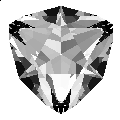 R.I. = 1.60 (red) |
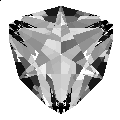 R.I. = 1.66 (blue) |
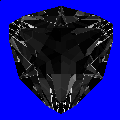 Dispersion Measure 27.6 |
The stone with artificially enhanced dispersion shows considerably more flashes of fire in the corners, and even some indications of colour on the large facets. Based on the random raytraces returned by GemRay, BOG assigned this stone a Dispersion Measure of 27.6, almost three times higher than before. |
To get an impression of how such dispersion would influence the real-world appearance of this stone, you can run the Colour Raytrace in the PlayPen (see here for details). This option calls GemRay three times, once for red, green, and blue light, then assembles a full colour image. Although this is only an approximation, the PlayPen indicates signficant flashes of colour for this design when cut in "Tourmaline Zirconium".
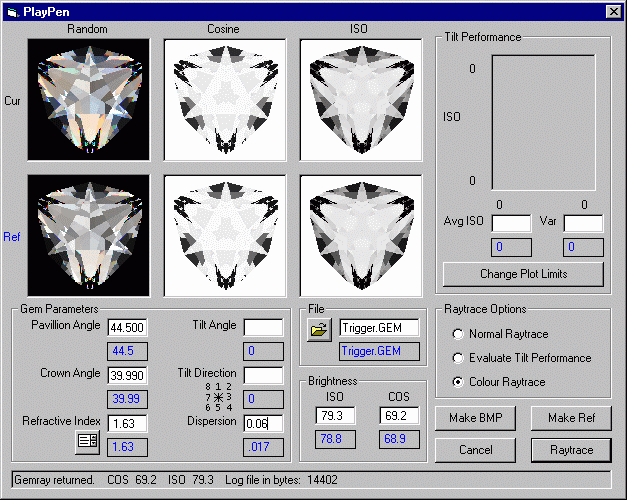 |
The images at left show the stone cut in "Tourmaline Zirconium" (top - R.I. 1.63 and dispersion 0.06) compared with regular Tourmaline (bottom). The leftmost frame is the colour raytrace. Both designs show flashes of colour, although clearly the enhanced dispersion material has more "Fire". |
Back to Main Page.
Documentation maintained by Tom Herbst. Last modified 16-Aug-2005